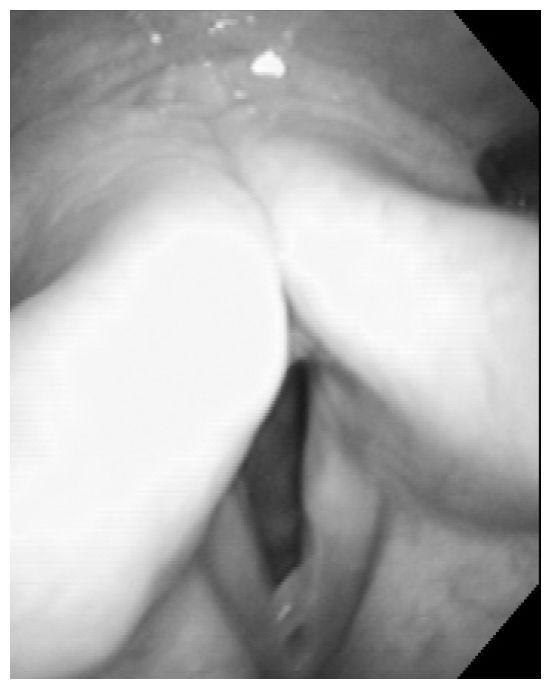Vocal Polyps in Tourette Syndrome
Article information
Abstract
Hoarseness and dysphonia are often a result of vocal cord polyps which in turn, are linked to vocal trauma. We report the case of vocal polyps in the setting of a 27-year old male with a history only remarkable for Tourette syndrome. We review the literature regarding etiology and pathophysiology of vocal cord lesions and propose vocal tics in Tourette syndrome as an under-recognized etiology. In this way, we also review therapies that may aid in treating not only the vocal cord lesions but also particularly in the setting of vocal tics.
Laryngeal lesions such as vocal cord nodules and polyps are common occurrences that are typically associated with progressive hoarseness and dysphonia. While it is has been demonstrated that these vocal cord lesions are of multifactorial origin, vocal cord abuse appears to be paramount to the development of such pathology.1 Specifically, nodules are typically attributed to younger females with professions associated with increased voice use and repeated vocal cord trauma - leading to hyalinization of Reinke’s space, epithelial thickening and hyperplasia on the cords bilaterally.2 Vocal cord polyps however, are primarily found as bilateral lesions in smokers with or without histories of intense intermittent vocal abuse or some form of vocal trauma. Though not fully understood, it is believed that initially, there is a capillary breakage in Reinke’s space causing blood to extravasate, local edema, and the resulting lesion.3 In spite of its theoretical pathologic difference from nodules with a more fibrous stroma, it is often difficult for the pathologist to separate the two.
We report a case of a patient with unilateral vocal cord polyp not secondary to intense vocal abuse, but to chronic vocal cord abuse resulting from vocal tics in Tourette syndrome.
Case
Mr. A.L. is a 27-year old male, who was originally diagnosed at the age of 6 with Tourette’s syndrome manifested by vocal tics, presented to his family physician with a 4-month history of hoarseness. He denies any history of trauma or vocal abuse prior to his symptoms. He is an overall two-pack year smoker, but has quit. Mr. A.L. is treated for his Tourette’s syndrome using haloperidol 1 mg twice daily, clonazepam as needed and sertraline. On physical examination, he was found to have a hoarse voice and vocal tics. Direct flexible nasopharyngoscopy revealed a polypoid lesion originating from the free edge of the anterior left true vocal fold (Figure 1). This lesion was amenable to transoral endoscopic microsurgical resection using a carbon dioxide (CO2) laser, and after a discussion with the patient, he agreed to proceed with resection. Mr. A.L. was also asked to completed the University of Michigan Voice-Related Quality of Life (V-RQOL) questionnaire which he scored 24 overall and considered his voice quality as poor.
Intraoperatively a left vocal fold lesion was identified and completely resected. Gross pathology demonstrated the small lesion to measure 0.3 × 0.2 × 0.1 cm. No dysplasia or malignancy was identified and the lesion was diagnosed as a vocal cord polyp.
Two weeks after endoscopic CO2 resection of the left vocal fold lesion, repeat laryngoscopic examination revealed complete resolution of the lesion with no evidence of scarring or web. Mr. A.L. repeated the V-RQOL questionnaire post-operatively and scored 11 overall and rated his voice quality as very good.
Discussion
The relationship between vocal trauma, smoking, and gastroesophageal reflux disease and vocal cord polyps is well documented.1 Other rare cases of recurrent vocal cord polyps have been documented in relation to autoimmune diseases such as systemic lupus erythematosus and Hashimoto’s thyroiditis.2 While there is substantial evidence for vocal cord trauma, a review of literature failed to demonstrate previous documentation of a relationship between vocal tics or Tourette syndrome and vocal fold lesions.4–10
The etiology, pathophysiology and clinical manifestations of vocal polyps and nodules are well understood. Traditionally, polyps are associated with intermittent intense vocal abuse and smoking while vocal nodules are thought to arise from chronic minor vocal cord abuse. In the case of Mr. A.L., he has no history of using his voice professionally or episodes of intense trauma. Further, he also has no history of gastroesophageal reflux disease or autoimmune diseases. The cause of this patient’s laryngeal lesion then is likely secondary to the history of chronic minor vocal cord abuse suffered from vocal tics in his Tourette syndrome. In this way, we also demonstrate that the minor laryngeal trauma has led to the development of a polyp rather than bilateral nodules. As it has been shown previously, it can be difficult for a pathologist to distinguish polyps and nodules.11,12
As previously stated, we had treated his hoarseness by excising the causative lesion. On the other hand, should this situation recur in this patient given the continuing vocal tics, definitive treatment for the vocal tics should be pursued. Unfortunately, unlike other incidences of vocal trauma, voice coaching would not be beneficial. More recently, Vincent et al.13 has shown the advantages of using botulinum toxin in the treatment of laryngeal tics.
Despite the possible confounding history of cigarette smoke exposure, it is important to include Tourette syndrome in the differential diagnosis of hoarseness. Moreover, the possibility of vocal cord polyps should not be isolated to those patients who use their voice professionally. With the evidence from this case report, further study into the prevalence of vocal cord lesions in patients with Tourette syndrome manifested by vocal tics may be warranted.
Notes
The authors have no financial conflicts of interest.
